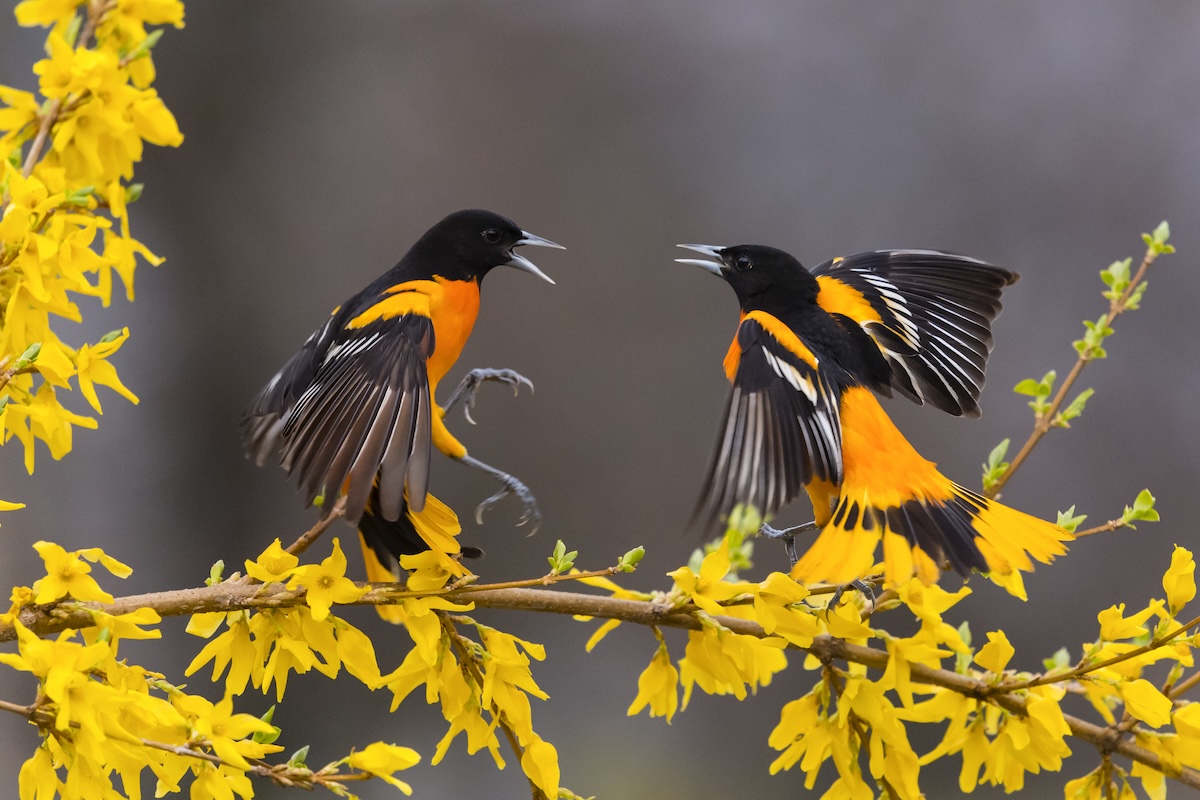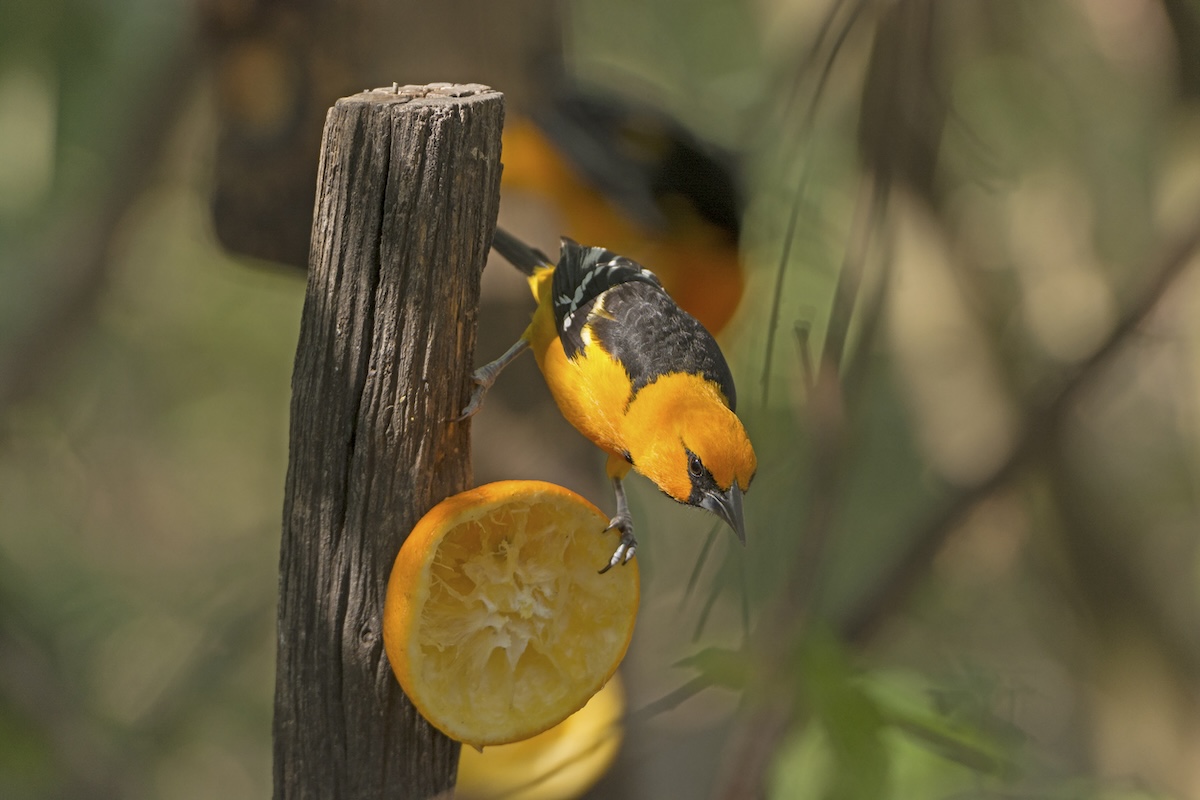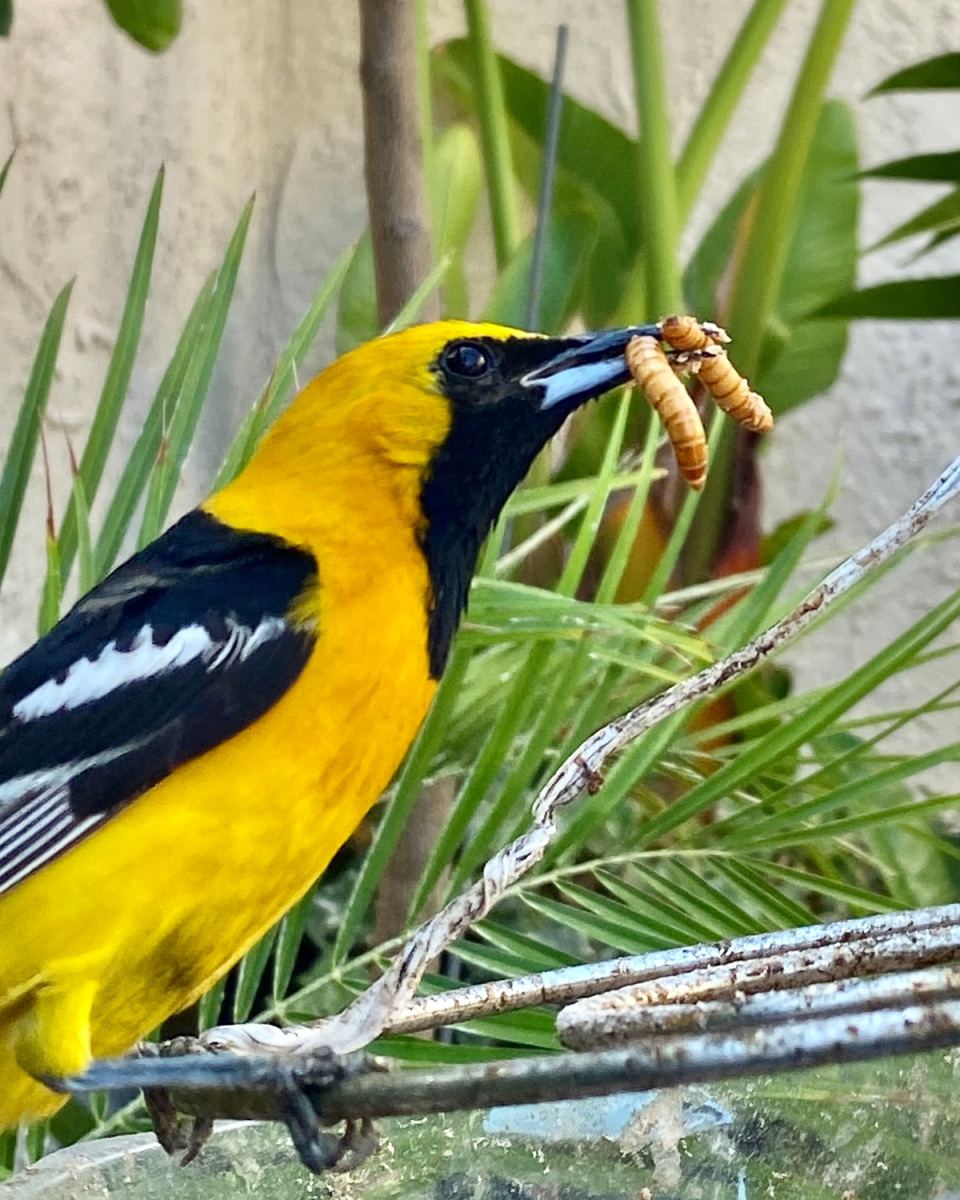We may earn revenue from the products available on this page and participate in affiliate programs. Learn More ›
Many birders and homeowners take special delight in seeing the orange oriole bird return from its winter sojourn south of the border. Several species of oriole are found in various regions of the U.S., almost all of which sport colorful plumage.
You may be prepared to attract many types of birds to your yard with strategic placement of feeders and water sources, but do you know how to attract orioles? Attracting orioles requires specific tactics, but the reward of seeing these bright orange birds is worth the effort.
1. Put food out early.

Orioles are some of the earliest migratory birds to arrive in the U.S. and one of the first types of birds to fly south. Be prepared for oriole feeding early in the year. If you don’t put food out at the right time, you may miss them altogether. They may reach Texas, Louisiana, Georgia, and Alabama as early as late February, but April is peak migration for many of the oriole species. Similarly, they head south before most other birds—with peak migration for some species in August. Whichever direction they’re traveling, they need lots of fuel for the trip.
2. Appeal to their sweet tooth.

One of the best ways to attract them is by providing the right food for orioles. Orioles don’t eat seeds; they like sugary foods. When feeding orioles, entice them with the same (undyed) sugar water used in hummingbird feeders. In addition to nectar, orioles like oranges, which are easily served in halves, apples, pears, peaches, and other dark fruit, such as blueberries, blackberries, grapes, and black currants. Orioles particularly like the flavor of grape jelly, which should be served in small amounts in an open dish. Mealworms are a summertime favorite for a bit of protein.
3. Get the right kind of feeder.

The best oriole feeders for attracting Baltimore orioles and all other orioles are orange. Nectar feeders should have perches large enough to support orioles and drinking ports big enough for them to access. Fruit feeders need at least two spears to hold orange halves, facing outwards. Jelly feeders should be shallow pans. “Installing a few different types to cater to their diet preferences can be very effective,” says Diana Ludwiczak, licensed wildlife rehabilitation specialist in New York City and founder of Birdy Birdy Birdy, a website dedicated to information about birds. Whatever type of feeder you choose, clean and disinfect it regularly to prevent the spread of mold and disease.
4. Keep oriole feeders separate but visible.

Because most species of orioles roost high in the treetops, oriole bird feeders should be placed in the open, where they’re easily seen from above. They should not be placed under a heavy canopy of trees, which can obscure them when birds are flying overhead. Nor should they be too close to the house, for the birds’ sense of security. An open area near shrubs or other protective greenery is best for orioles, who are a bit shy and don’t like to visit feeders where noisy, rowdy birds congregate.
5. Plant (tall) fruiting trees and shrubs.

Tall trees provide shelter for orioles, creating safe places to perch, hide, and build nests. You’ll find most oriole species, including Baltimore orioles, nesting in tall treetops. Their nests are hanging, woven sock-like baskets made of grass, vines, strips of bark, twine, or animal hair. Trees and shrubs provide protection from predators as well as shelter. Native fruit-bearing trees and shrubs are additional lures for orioles, which like mulberries, cherries, huckleberries, blackberries, raspberries, and elderberries. Ludwiczak says orioles are drawn to brightly colored blooms like trumpet vine, honeysuckle, and columbine. “These plants also attract insects, a significant part of the oriole’s diet.”
6. Provide a water source.

A source of water invites orioles, as it does all birds. “A birdbath with clean, fresh water is attractive to orioles, as they need to drink and bathe,” Ludwiczak says. Because orioles are bigger birds, they would appreciate a large basin. The sight and sound of moving water are big attractions for orioles. “Consider adding a fountain or a dripper to keep the water moving, as this is more likely to draw their attention,” Ludwiczak suggests. A bubbler in the birdbath would tempt orioles even more.
7. Minimize pesticide and herbicide use.

Pesticides can indirectly kill orioles. “Since orioles eat insects, using pesticides can reduce their food sources and potentially poison the birds,” Ludwiczak says. Herbicides reduce the insect population by eliminating the weeds they feed on. Other, sub-lethal effects pesticides and herbicides can have on orioles include: lack of appetite, weight loss, suppressed immune system response, thin eggshells, deformed embryos, slower nesting growth rates, decreased parental attentiveness, lethargy (less time spent foraging), and reduced territorial defense. Instead, Ludwiczak suggests, “Emphasize organic gardening practices to ensure a safe environment for orioles and other wildlife.”
Common Types of Oriole Birds You Might See
Did you know there are eight types of oriole birds found north of the Mexican border? Of those, only five are considered common, and at least one or two can be found in just about any part of the U.S. during the summer.
- Baltimore oriole: A medium-size bird with a sturdy body, the iconic Baltimore oriole has a thick neck, long legs, and pointed bill. Males have a black head and back (with white streaks), with orange rump and tail feathers. Females can have a brown or yellow head and back, with a yellow tail. They’re common in most eastern states and southeastern Canada.
- Bullock’s oriole: Closely related to the Baltimore Oriole, the Bullock’s Oriole is found in western states and the Great Plains, where they sometimes breed with their eastern relatives. Males have orange faces, a black throat, white patches on their wings, and a black horizontal line across their eyes. Females are lighter orange and have grayer wings.
- Hooded oriole: The belly and head of the hooded oriole is a sunny yellow-orange color. Males have a black throat, with black and white streaks on their wings and tails. Females don’t have the throat patch and their coloring is more subtle. Sometimes called “palm-leaf orioles” because they like to nest in palm trees, the northern boundary of their territory stretches from Texas to California across the Southwest.
- Orchard oriole: The smallest of the species at just over 7 inches long, the orchard oriole frequents orchards, the edges of woods, or other semi-open areas with short trees in eastern and central U.S. Males feature a dark chestnut belly and a black tail, with black, orange, and white on their wings. Females are pale grayish-yellow, with gray and white on their wings. These community birds often nest in trees where other oriole nesting is present, and even get along with birds of other species.
- Altamira Oriole: The largest oriole in the U.S., at 10 inches from bill tip to tail tip, the Altamira oriole is bright orange with a black throat and tail, and wings that are predominantly black with white streaks. Females look like the males. While these orioles live mostly in Central America and along the Mexican Gulf Coast, they can also be found in the Rio Grande Valley of Texas year-round.
In addition to the five most frequently seen orioles, lucky birders might also spot Audubon’s orioles, Scott’s orioles, and spot-breasted orioles.


